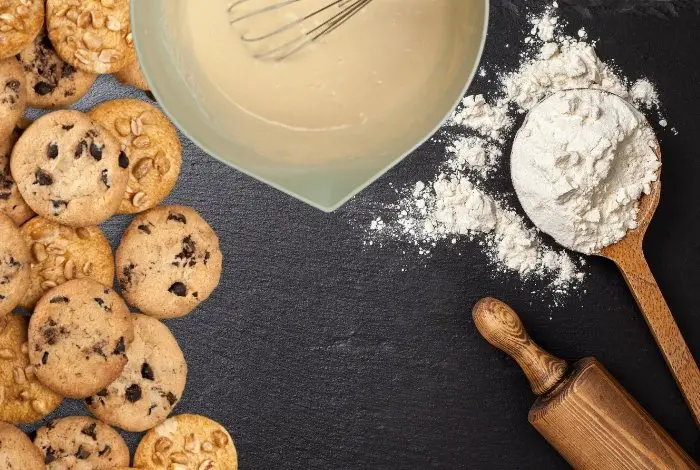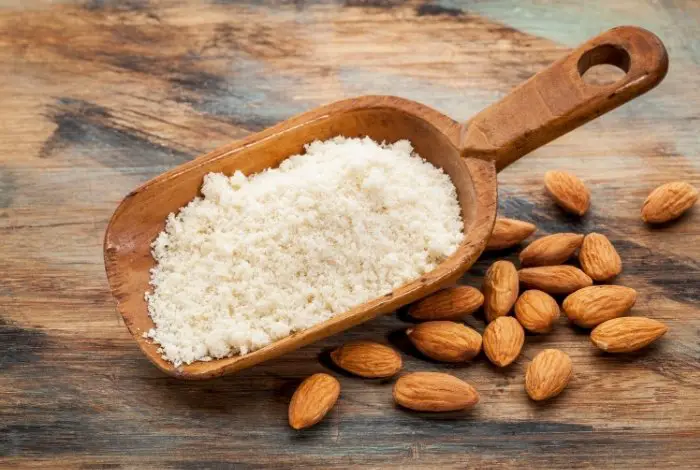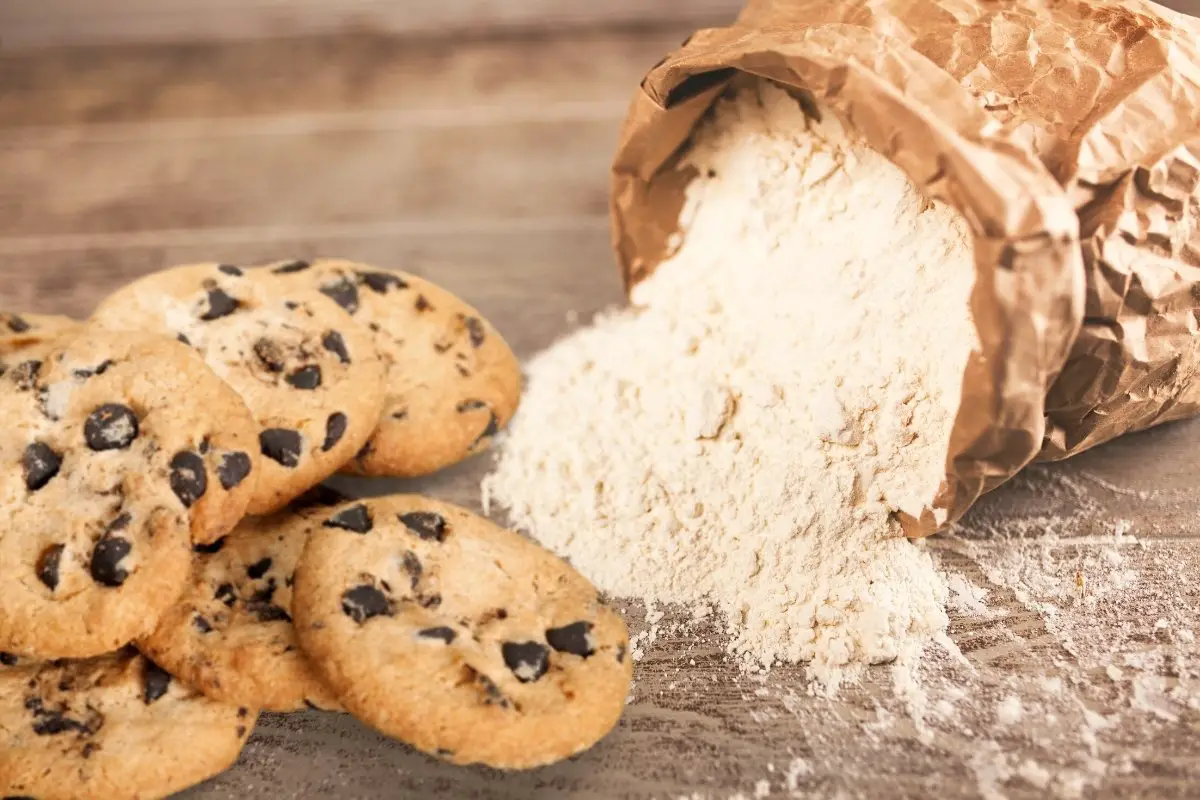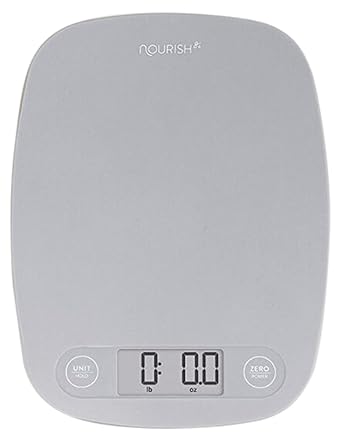Last Updated on February 27, 2023
When it comes to making cookies flour is one of the most important ingredients. So, just what does flour do in cookies?
As the first ingredient in cookie recipes, flour is essential to a delicious cookie. Without it, the cookie would not come together and you would have an ooey-gooey mess. Flour is not something you can simply leave out of cookies if you don’t have it.
What Does Flour Do in Cookies?
Flour works as a stabilizer and thickener in cookies. In addition, flour also contributes to how much the cookie rises and holds it together. It also works to give the cookies a nice, delicious texture.
When baking cookies, too much flour can cause them to lose flavor and have a thick texture. Too little flour and the cookies will fall apart, as they will be too runny. It is important to get the exact amount the recipe calls for, as the wrong amount can mess up your cookies.
Depending on the ratio of flour in the recipe, it can make cookies chewy, crispy, or crunchy. Chocolate chip cookie recipes will vary the flour amount depending on the result of the cookie. Shortbreads will have a high proportion of flour to butter, to give them a lovely crumbly texture.

What Flour Do You Use in Cookies?
When it comes to baking, there are several different types of flour. There is all-purpose, cake, bread, almond, whole wheat, self-rising, gluten-free, and more. Each of these serves a specific purpose, making them good for different things.
1. All-purpose flour
All-purpose is the most popular type of flour used. It is by far the most common flour used for baking cookies. It provides cookies with a wonderful, delicious texture. Depending on the ratio in your recipe, it can make your cookies chewy, crispy, or crunchy.
2. Cake flour
Some cookie recipes call for cake flour. Since cake flour has less protein than all-purpose flour, it creates a more delicate texture. Though it can make for a softer, more delicate cookie, it can also make them too crumbly so you have to be careful.
3. Self-rising flour
Though self-rising flour can be used to make cookies, adjustments must be made to the recipe. With recipes that call for 1/2-1 teaspoon of baking powder per cup, self-rising flour can be used. Be sure to leave out the salt and baking powder if you are using self-rising flour for cookies.
4. Almond flour
Almond flour is a popular choice as a gluten-free and wheat-free flour. It is used in macaron recipes, as it gives them a lovely chewy texture and taste. Other cookie recipes can also use almond flour, however, since it is denser than other flour so baking soda/powder needs to be increased.

5. Bread flour
Though bread flour is typically only used for bread, it can also be used in cookie recipes. It gives cookies a tasty chewy texture.
6. Whole wheat flour
Whole wheat flour can also be used in cookies. It creates a hearty, yet tender cookie. However, it is a denser flour so you have to be careful when using it in your recipe.
Best Way to Measure Flour When Baking
When it comes to measuring flour, it can be easy for people to measure out the wrong amount, messing up the recipe. Though it can be tempting to scoop the flour right out of the bag using a measuring cup, this can add up to 30% more flour to your recipe. This can mess up the flavor and texture of the cookies you are baking.
The best way to measure flour for your recipe is to use a kitchen scale. Using a scale will allow you to get the exact amount of flour your recipe calls for, ensuring that you will have the best cookies possible. It is an easy and effective way to measure flour.
If you don’t have a kitchen scale, the next best way to measure flour is by spooning and leveling. Simply use a spoon to fill up the measuring cup and once it is full, use a knife to level off the top. Though this is not as effective as using a kitchen scale, it can help you measure out the right amount of flour without packing it down, which adds too much.
GreaterGoods Digital Food Kitchen Scale
Can You Use Unbleached Flour for Cookies?
Yes, you can use unbleached flour for cookies. However, many people prefer to use bleached flour. Bleached flour gives cookies a softer, fluffier texture.
Bleached flour is treated with chemicals to speed up the aging process. This results in finer flour with more volume and texture.
Unbleached flour, on the other hand, ages naturally after the milling process. It tends to have a bit denser texture than bleached flour. Unbleached flour has more protein than bleached flour and weighs slightly more.
In most cases, you can use bleached and unbleached flour interchangeably. It does generally not result in vast differences in your cookie recipes. Unless specified by the recipe, there should be no changes if you use bleached or unbleached flour.
In most cases, the flour you buy at stores is bleached. However, unbleached flour is also readily available at grocery stores.
How Different Ingredients Affect Cookies
Above, we stated what role flour plays in cookies. Flour works as a stabilizer and thickener in cookies, giving them a base to which flavors and textures can be added.
It is important to measure flour properly, as too much flour in cookies and not enough flour in cookies can have negative effects on the final results.
Butter
Butter is a common ingredient found in most cookie recipes. Depending on the recipe, the butter may be melted or added in at room temperature.
Butter has many purposes in cookies. It works to provide flavor, richness, tenderness, and structure. It is one of the most important ingredients in cookies.
Sugar
Sugar is another important ingredient in cookies. Depending on the recipe, it may use granulated sugar, brown sugar, or both.
Sugar not only provides flavor to cookies but also helps with structure. Sugar helps lock in moisture while giving cookies their wonderful texture.
While some people wanted to reduce the amount of sugar in cookies to make them healthier, this is generally not a good idea. Not only will it affect the flavor, but also the texture and structure as well.
Eggs
A lot of cookie recipes will call for eggs. Eggs work to provide structure to cookies while also working as a leavening agent.
Some cookie recipes will call for an extra egg yolk to provide chewiness. On the other hand, some cookie recipes may call for an extra egg white for a light, fluffy texture.
Vanilla Extract
Vanilla extract is one of the most common flavoring additives to cookies. Almost all cookie recipes will call for vanilla extract as it provides cookies with delicious flavor. Other common extracts for cookies include almond, peppermint, and lemon.
Salt
Most people associate salt with savory dishes, however, it is also an important part of sweet dishes too. Salt helps enhance the flavor for a better-tasting cookie.
Baking Powder and/or Baking Soda
Baking powder and baking soda are two types of leavening agents. They are important to the texture of your cookies as they give them texture and prevent them from going flat.
What Does Flour Do in Cookies? The Key to a Perfect Cookie
Flour is a vital ingredient when it comes to baking cookies. It plays a big role in the texture and taste of cookies.
Do you have any questions regarding what flour does in cookies? If so, please ask your questions in the comments down below.

Ever since she was a young girl, Anna has been a lover of desserts. As an adult, she enjoys
baking a variety of desserts from cakes, cookies, brownies, bread, and more from scratch. She
enjoys sharing her passion for baking with others who also have a sweet tooth. From properly
measuring ingredients to making sure they are the correct temperature, Anna knows the
importance small details can make in baking. She wants to share her experience with others in
hopes they can make the most delicious baked goods. When she’s not busy blogging, Anna
enjoys trying new recipes in the kitchen.


